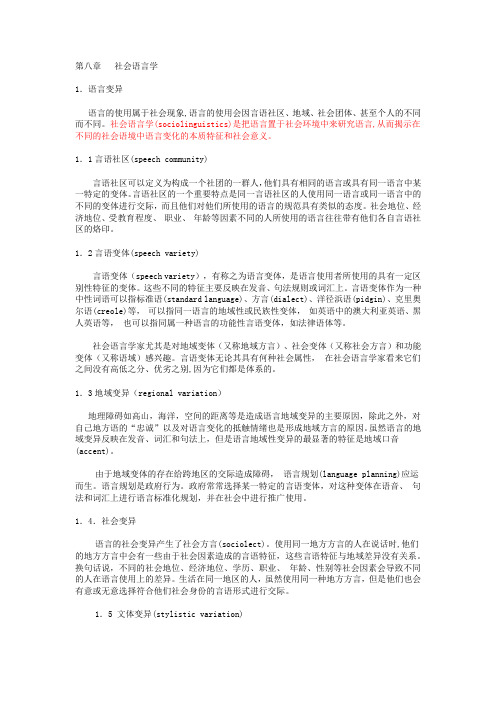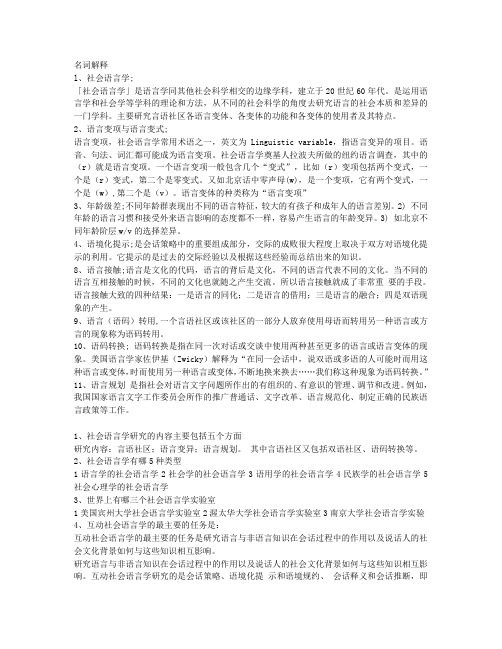社会语言学
社会语言学和语言社会学 英文解释

社会语言学和语言社会学英文解释
社会语言学(Sociolinguistics)是研究语言在社会中如何使用、变化和发
展的学科。
它关注语言与社会的相互关系,包括语言的变化、语言的多样性、语言的社会功能、语言与身份的关系等等。
社会语言学试图理解语言在社会生活中的作用,以及社会因素如何影响语言的使用和变化。
语言社会学(Sociology of Language)是研究语言在社会结构和社会变迁中的地位和作用的学科。
它关注语言的形成、变化和发展,以及语言如何影响社会的形成和发展。
语言社会学也研究语言在社会中的功能,以及语言如何反映和塑造社会结构和文化。
简而言之,社会语言学更关注语言在社会生活中的具体应用和变化,而语言社会学更关注语言在社会结构和文化中的作用和地位。
这两个学科有很多交叉点,但研究重点和方法有所不同。
社会语言学的基本概念

社会语言学为语言教育课程设置和教 材编写提供理论指导,确保教学内容 的实用性和针对性。
教师培训与教学评估
社会语言学有助于教师培训和教学评 估,提高教师的教学水平和评估能力 。
06
社会语言学的未来展望
语言与人工智能的结合
自然语言处理
利用人工智能技术,实现机器对人类语言的自动识别、理解和生 成,提高人机交互的效率和准确性。
语言规划实施
社会语言学关注语言规划的实施过程, 分析实施效果,提出改进建议,促进 语言规划的可持续发展。
跨文化交际
文化差异识别
社会语言学帮助人们识别不同文化间的语言 差异,促进跨文化交流的顺利进行。
交际能力培养
社会语言学强调培养交际能力,包括语言使 用得体、文化适应等,提高跨文化交际的效 果。
语言教育
语言与身份认同研究
关注个体和群体如何通过语言 表达和建构身份认同。
语言与文化研究
研究语言与文化之间的相互关 系,包括文化传承、文化交流 和文化冲突等方面。
语言政策与规划研究
关注政府和机构如何制定和实 施语言政策,以及这些政策对
社会的影响。
03
社会语言学的主要研究内 容
社会语境中的语言使用
语言使用与社会环境
社会语言学的起源与当时的社会文化背景密切 相关,随着社会的发展和人口迁移的增加,语 言接触和变异现象引起了学者们的关注。
社会语言学的起源也与语言学、社会学、人类 学等学科的交叉研究有关,这些学科的理论和 方法为社会语言学的发展提供了基础。
发展历程
20世纪60年代
社会语言学兴起,研究重点在于语言变异和 语言接触。
语言变化研究
社会语言学关注语言随时间和社会变迁而产生的变化,包括语音、词 汇、语法等方面的变化,探究这些变化的动因和规律。
社会语言学名词解释

社会语言学名词解释
社会语言学是一门研究人类语言和社会文化之间的相互作用和
关系的学科,主要关注语言使用的场合、语言使用的人群、语言使用的条件等因素,旨在揭示语言和社会文化之间的本质联系。
社会语言学的研究对象包括语言、文化、社会、认知等多个方面。
社会语言学的主要研究方法包括定量和定性研究。
定量研究主要是通过调查问卷、定量分析语言数据等方式,研究语言使用的人群特征和社会文化背景。
定性研究则是通过访谈、观察等方式,研究语言使用的场景和条件,以及语言使用对个人和社会的影响。
社会语言学的重要领域包括跨文化交流、语言交际、社会心理学、认知科学等。
在跨文化交流方面,社会语言学研究不同文化之间的语言差异,探讨语言差异对交际关系的影响,提倡跨文化交流和理解。
在语言交际方面,社会语言学研究语言使用的场景和条件,探讨语言使
用对交际效果的影响,提出有效的语言交际策略。
在社会心理学方面,社会语言学研究语言使用和心理过程的关系,探讨语言使用的心理因素,研究人类认知的特点和语言使用的关系。
在认知科学方面,社会语言学研究语言和思维之间的联系,探讨语言使用的认知能力,提出认
知语言学的概念和研究方法。
社会语言学的定义

社会语言学的定义
社会语言学的定义:
社会语言学是一门从人类社会生活的角度观察语言的运用,或从语言的角度探索人类社会生活的语言学分支学科。
社会语言学属于广义的应用语言学。
社会语言学是在20世纪60年代在美国首先兴起的一门边缘科学。
它主要是指运用语言学和社会学等学科的理论和方法,从不同的社会科学的角度去研究语言的社会本质和差异的一门学科。
社会语言学有两个主要的检索领域:第一是社会生活的变化将引起语言(诸因素)的变化,其中包括社会语境的变化对语言要素的影响;第二是从语言(诸因素)的变化探究社会(诸因素)的变化。
第八章 社会语言学

第八章社会语言学1.语言变异语言的使用属于社会现象,语言的使用会因言语社区、地域、社会团体、甚至个人的不同而不同。
社会语言学(sociolinguistics)是把语言置于社会环境中来研究语言,从而揭示在不同的社会语境中语言变化的本质特征和社会意义。
1.1言语社区(speech community)言语社区可以定义为构成一个社团的一群人,他们具有相同的语言或具有同一语言中某一特定的变体。
言语社区的一个重要特点是同一言语社区的人使用同一语言或同一语言中的不同的变体进行交际,而且他们对他们所使用的语言的规范具有类似的态度。
社会地位、经济地位、受教育程度、职业、年龄等因素不同的人所使用的语言往往带有他们各自言语社区的烙印。
1.2言语变体(speech variety)言语变体(speech variety),有称之为语言变体,是语言使用者所使用的具有一定区别性特征的变体。
这些不同的特征主要反映在发音、句法规则或词汇上。
言语变体作为一种中性词语可以指标准语(standard language)、方言(dialect)、洋径浜语(pidgin)、克里奥尔语(creole)等,可以指同一语言的地域性或民族性变体,如英语中的澳大利亚英语、黑人英语等,也可以指同属一种语言的功能性言语变体,如法律语体等。
社会语言学家尤其是对地域变体(又称地域方言)、社会变体(又称社会方言)和功能变体(又称语域)感兴趣。
言语变体无论其具有何种社会属性,在社会语言学家看来它们之间没有高低之分、优劣之别,因为它们都是体系的。
1.3地域变异(regional variation)地理障碍如高山,海洋,空间的距离等是造成语言地域变异的主要原因,除此之外,对自己地方语的“忠诚”以及对语言变化的抵触情绪也是形成地域方言的原因。
虽然语言的地域变异反映在发音、词汇和句法上,但是语言地域性变异的最显著的特征是地域口音(accent)。
由于地域变体的存在给跨地区的交际造成障碍,语言规划(language planning)应运而生。
社会语言学概论知识点总结

社会语言学概论知识点总结社会语言学是语言学的一个重要分支领域,它研究语言在社会和文化环境中的运用和演变。
通过社会语言学的研究,我们可以了解语言与社会之间的相互关系,深化对语言的理解,促进语言教育和跨文化交流。
下面,我们将对社会语言学的一些重要知识点进行总结和分析。
一、语言和社会1. 语言的社会功能语言不仅是人类交流的工具,更是社会交往的重要媒介。
社会语言学研究语言在社会中的作用和功能,包括信息传递、社交互动、文化传承等方面。
通过研究语言的社会功能,可以更好地理解语言的本质和价值,对语言运用和教育有深远影响。
2. 语言和身份认同语言是个体和群体身份认同的重要标志。
社会语言学研究了语言与社会身份、地域、文化等因素的关系,揭示了语言对身份认同的影响和作用。
不同的社会群体使用不同的语言和变体,反映了他们的特定社会身份和归属感。
3. 语言政治与权力语言是权力和政治的工具,在不同社会和文化中存在着语言的政治化现象。
社会语言学研究了语言政治对语言使用和语言变体的影响,以及不同语言在权力和政治领域中的地位和作用。
研究语言政治有助于深化对权力和文化关系的认识,促进语言权利的保护与促进。
二、语言变体与语言变化1. 语言变体社会语言学研究了语言的地域变体、社会变体、个人变体等不同层面上的语言变体现象。
地域变体指不同地区的语言差异,社会变体指不同社会群体的语言使用差异,个人变体指个体语言使用的差异。
了解语言变体可以帮助我们理解语言的多样性和动态性,促进跨文化交流和交际。
2. 语言变化语言是不断变化的,社会语言学研究了语言变化的原因和规律。
语言变化可以是由外部因素(如社会变迁、接触语言等)或内部因素(如语音、词汇、语法等方面的演变)所导致。
了解语言变化有助于我们把握语言发展的趋势和规律,促进语言教育和翻译工作。
三、语言接触与语言习得1. 语言接触语言接触指不同语言和语言变体之间的交际和交流。
社会语言学研究了语言接触的影响和结果,包括语言借词、语言转换、典型联系等现象。
《社会语言学》课件

实证研究是社会语言学研究的重要方法之一。未 来,社会语言学将更加注重实证研究,通过实地 调查、实验等方法来验证理论假设和探究语言现 象的本质。
THANKS FOR WATCHING
感谢您的观看
语言中的文化信息
探讨语言中蕴含的文化信息,如价值观、信仰、 习俗和传统等。
跨文化交际
研究不同文化背景的人们在交际过程中如何理解 和使用语言。
语言与性别
性别与语言使用
01
研究不同性别在语言使用上的差异,包括词汇、语调和话题选
择等。
性别与语言权利
02
探讨性别如何影响语言权利的变化
03
研究语言变化过程中性别的角色和影响,以及性别如何影响语
言的演变。
语言与年龄
年龄与语言使用
研究不同年龄段在语言使用上的差异,包括词汇、语法和语用等 。
代际差异与语言传承
探讨不同代际之间在语言使用上的差异,以及这些差异如何影响 语言的传承和发展。
年龄与语言变化
研究年龄因素在语言变化中的作用,以及年龄如何影响语言的演 变和发展。
03 社会语言学理论
语言与社会结构
01
语言与社会结构相互影响
语言不仅是社会结构的反映,同时也参与构建社会结构。社会结构中的
各种因素,如阶级、性别、年龄等,都在一定程度上影响语言的使用。
02 03
社会方言与地域方言
不同的社会群体和地域会有不同的语言变体,这些变体被称为社会方言 和地域方言。社会方言主要反映社会群体的差异,地域方言则反映地理 区域的差异。
社会语言学
目录
• 社会语言学概述 • 社会语言学研究的主要内容 • 社会语言学理论 • 社会语言学应用 • 社会语言学的挑战与未来发展
社会语言学

名词解释l、社会语言学;「社会语言学」是语言学同其他社会科学相交的边缘学科,建立于20世纪60年代。
是运用语言学和社会学等学科的理论和方法,从不同的社会科学的角度去研究语言的社会本质和差异的一门学科。
主要研究言语社区各语言变体、各变体的功能和各变体的使用者及其特点。
2、语言变项与语言变式;语言变项,社会语言学常用术语之一,英文为Linguistic variable,指语言变异的项目。
语音、句法、词汇都可能成为语言变项。
社会语言学奠基人拉波夫所做的纽约语言调查,其中的(r)就是语言变项。
一个语言变项一般包含几个“变式”,比如(r)变项包括两个变式,一个是(r)变式,第二个是零变式。
又如北京话中零声母(w),是一个变项,它有两个变式,一个是(w),第二个是(v)。
语言变体的种类称为“语言变项”3、年龄级差;不同年龄群表现出不同的语言特征,较大的有孩子和成年人的语言差别。
2) 不同年龄的语言习惯和接受外来语言影响的态度都不一样,容易产生语言的年龄变异。
3) 如北京不同年龄阶层w/v的选择差异。
4、语境化提示;是会话策略中的重要组成部分,交际的成败很大程度上取决于双方对语境化提示的利用。
它提示的是过去的交际经验以及根据这些经验而总结出来的知识。
8、语言接触;语言是文化的代码,语言的背后是文化,不同的语言代表不同的文化。
当不同的语言互相接触的时候,不同的文化也就随之产生交流。
所以语言接触就成了非常重要的手段。
语言接触大致的四种结果:一是语言的同化;二是语言的借用;三是语言的融合;四是双语现象的产生。
9、语言(语码)转用,一个言语社区或该社区的一部分人放弃使用母语而转用另一种语言或方言的现象称为语码转用。
10、语码转换; 语码转换是指在同一次对话或交谈中使用两种甚至更多的语言或语言变体的现象。
美国语言学家佐伊基(Zwicky)解释为“在同一会话中,说双语或多语的人可能时而用这种语言或变体,时而使用另一种语言或变体,不断地换来换去……我们称这种现象为语码转换。
- 1、下载文档前请自行甄别文档内容的完整性,平台不提供额外的编辑、内容补充、找答案等附加服务。
- 2、"仅部分预览"的文档,不可在线预览部分如存在完整性等问题,可反馈申请退款(可完整预览的文档不适用该条件!)。
- 3、如文档侵犯您的权益,请联系客服反馈,我们会尽快为您处理(人工客服工作时间:9:00-18:30)。
An Analysis of the Features and Causes of Female Language1401 全雪萍1430100137Introduction:The study of gender language has a long history. As early as 1922, Jens Otto Harry Jesperson has specially opened up a chapter of “ The Women” in his book Language, which discusses the language differences between men and women. Since the 1970s, some famous scholars such as Lakoff , Trugill and others advanced the study to systematize the study of gender study.In recent years, the studies of “female language” are increasing in many magazines and books, which draws much attention. Many researchers have almost reached the same conclusion that women have their own language. Crosby and Nyquist got the conclusion from their studies: the so-called female language is not existed since women are born, but this kind of language reflects the people in the society always put the female in this position that is hard to change.In our society, the female language is characterized by a lack of social status. In this paper, I will start from the features of female language, and simply discuss the factors of its formation.I.The features of female languageMany observers believe that men and women are different in language communication. The female language exists in any language as a widespread phenomenon. Men and women have different choices in expressing ideas when they use the same language. For example, abstract nouns have gender differences in grammar, men call women as “ feminine”, while women call men as “masculine”. The education received by women is that they tone should be soft when they talk; do not refute others; be gentle and modest in language communication; avoid arbitrary or offending others; be aware of overconfidence. The features of female language can be summarized from following aspect:the choice of words, the choice of syntactic and pronunciation and intonation.1.The choice of wordsBoth men and women have their partial words, which can be said that a considerable number of words have been given the label of “feminine” or “masculine”. Men don‟t use( scorned, unwilling to use) some peculiar words in female language that is “ feminine” words. At the same time, women also avoid the “ masculine” expressions. Women often express their feelings without control, they like exaggeration when they talk, so they have the following characteristics of choosing words:1)Like using exaggerated adjectives, such as divine, charming, cute, gorgeous, heavenly” andso on. Men sometimes also use these words, but they rarely use these words to express the same meaning in terms of tradition. “ What a divine idea!” obviously comes from a woman‟s mouth.2)Like using some degree adverbs to emphasize, also like choosing some adverbs to strengthenadjectives, such as “ so” “quite” etc. Lakoff( 1972) and Tarone (1979) prove that men like using “very” and “really” while women like using “so”.3)Are good at using some color words, especially some rare color words, such as “ lavender,magenta, aquamarine”.4)Like adding “-ie” or “-y” after some words or appellations to express “intimacy” or “ little”,such as “ auntie, Billy” etc.5)Women pay more attention to the elegant, subtle language, and try to avoid vulgar words.Such as “ shit, damn, hell”, they prefer to say “ oh dear, god, my Heavens” and some other more gentle and implicit words.6)Using euphemism instead of unpleasant meanings or disrespectful expressions.7)Using more expressions marked as courtesy. Such as “ thank you”, “please” etc.2.The choices of syntacticSyntactic of female language doesn‟t have distinctive features like vocabulary of female language, but some features still show the gender differences in language. Women often use the following syntactic structures:1)Tag questionsWe find that women often add tag questions after some statements, in order to show courtesy, politeness and euphemism. They seldom use direct w ays to express their feelings. They don‟t say “ He can‟t do that.” , but say “He can‟t do that, can he?”. For example, nurses often say “ We are going to have our temperature taken, aren‟t we?”2)Ambiguous sentences and subjunctive mood sentencesWomen often use ambiguous sentences for showing respectfulness, politeness to the hearers. For example, the family nanny often use this kind of sentences: we are going to take our snap or go right to sleep.” women pay more attention to avoid direct order s or requests when they talk. For example, they always say “ Would you like to wash the dishes?”when they want their husband to wash the dishes.3)The regulating structureUsing this kind of very kind and polite structure can express tentative requirements or suggestions, also can avoid direct response. Using some words like “ I suppose, I think, I guess” or some uncertain words like “ probably, possibly, sort of, kind of” reflects women‟ s less confidence and less decisiveness than men.4)Standard syntactic formsWomen are more conscious than men in the use of standard syntactic forms. For example, women rarely use nonstandard multiple negatives . Besides, fewer nonstandard words are also found in female language.3.Pronunciation and intonationMen and women have phonetic differences in language, in addition to natural factors of voice forming, many phonetic differences between men and women in language are caused by social factors. It is widely acknowledged that women‟ s pronunciation are more standard, so it‟s more close to “ Received Pronunciation”(RP). Women lead the standards of language changes. Trugill and Fisher …s studies showed that the majority of men (62.2%) pronounce the “ing” to “in”, while only 28% women pronounce to “in” women have more opportunities to pronounce the lateral “ ɪŋ” than men. ( Trugill, 1983: 86)And women have more intonation changes than men, so women are more expressive. Generally speaking, women often use rising intonation in conversation in statement sentences to express in order to show their respect and create a relaxing atmosphere, not as decisive and affirmative as men using falling intonation. Because women do not have much assurance to show their decisive and affirmative attitude than men. For example:Husband: when will dinner be ready?Wife: Oh..., around six o‟ clock ?Although the wife can affirm that when dinner will be ready, she still use rising intonation to answer her husband in order to show her uncertainty and timidity.II.Factors contributing to the development of female language changes1.Physical and psychological factorsWomen‟ s physiological characteristics determine some features of female language, such as the high peach of tone, and they can master the correct language forms easily. Female unstable social status makes them very sensitive to the standard language which can reflect people‟s identity and status. In order to obtain the same power and status of men, women have been trying their best to use superior or standard language all the time in order to establish their own gender pronouns. This is why women‟ s language style and accent are closer to the standard and more elegant than men. Women tend to accept the idioms and jargons of so-called upper class for improving their social status. Women are the pioneers who brought standard language to their communities, and their language is bound to affect their offspring. Female language usually is more tactful, hesitant and ambiguous. On one side, it shows women‟ s lack of confidence; on the other side, it symbolizes the features of female language in female politeness theory.2.Social factorsThe language differences between men and women are also caused by many social factors such as cultural differences, social status and roles, they also reflect the different interests and different reactions to others of men and women. In almost every language society, men are always in the powerful and dominant position, while women are obedient and subordinate, thus female language also companies with consulting and obedience. Because women‟ s status and power on society are relatively inferior to men, they need to be timid, gentle, subtle and uncertain and like using rising intonation and avoiding problems. And the society specifies higher standards f or women‟ s words and deeds, so women often use mild and correct language style to communicate with others as possibly as they can in order not to offend others and to be discriminated. The duty of bearing and parenting children also makes them try to use polite and standard language. Besides, women pay more attention on the elegance of language than men, they prefer some pleasant words to get others‟ acknowledgment , even when they express their dissatisfaction. And women …s pronunciation is more correct and standard, it proves that men enjoy higher power in language using than women, women have to be obey the conventional standards.III.ConclusionThe gender differences of language is the result of different social division of labor and different position in social political and economic life of men and women, language will also change instantly if social attitudes towards men and women have some change. With the promoting of women‟ s power and status, the gender differences of language will also have different reflections. Now more and more women come to society, social work makes women become more confident when they talk, they still prefer gentle and tactful language, but they add more strength and flexibility to their language and the skills of female language also have been widely promoted. With the improvement of social civilization, the gender differences of language will be gradually reduced, even there will be no obvious differences in the future.References:Judith Orasanu et al. ( edt ). Language, Sex and Gender: Does La Difference Make a Difference? [M]. New York: The New York Academy of Science, 1979.Lakoff, R. Language and Women‟ s Place [M]. Harpers &Row Publishers, 1975.Trugill, D. Sociolinguistics: An Introduction [M]. Penguin Books, 1974.程欣,从女性语言特点看英语中性别歧视现象[M]. 郑州航空工业管理学院学报(社会科学版), 2011(30): 164-167.李红艳,论英语中女性语言的特点和对女性的语言性别歧视现象[M]. 中山大学研究生学刊(社会科学版), 2005(26): 122-128.于崇洛,张广保,美语中的女性语言[J]. 临沂师范学院学报, 2001(2):133-135.张爱玲,论女性语言的特点及其文化内涵[J]. 外语界, 1995(1):73-79.张从江,论英语中女性语言的特点[J]. 齐齐哈尔大学学报, 2002(7): 79-80.。
